Scandium Recovery from Aqueous Solution by Adsorption Processes in Low-Temperature-Activated Alumina Products
Abstract
:1. Introduction
2. Results and Discussions
2.1. Low-Temperature-Activated Alumina Products Characterisation
2.2. Zero Charge Point, pHpZc
2.3. Preliminary Sc(III) Adsorption Studies
2.4. Effect of the pH on Scandium Absorption Process
2.5. Effect of Contact Time and Temperature on the Scandium Adsorption on Sample GDAH-04-300
2.6. Kinetic Studies
- -
- Pseudo-first-order kinetic equation (Lagergren model) [68]:
- -
- Pseudo-second-order kinetic equation (Ho and McKay model) [69]:
2.7. Thermodynamic Studies
2.8. Equilibrium Adsorption
- -
- If n = 1, then adsorption is linear;
- -
- If n < 1, then adsorption is a chemical process;
- -
- If n > 1, then adsorption is a physical process.
3. Materials and Methods
3.1. Samples Materials
3.2. Scandium Adsorption Capacity of the Low-Temperature-Activated Alumina Products
3.3. Analysis Equipment
4. Conclusions
Author Contributions
Funding
Conflicts of Interest
References
- Lidia, K.; Gheorghe, D.; Raluca, I.; Sorin, I.; Lucian, C.; Alina, B.; Gina, A.C.; Laurentiu, F. Lanthanides as Impurities in the Bayer Production Cycle of the Aluminum Hydroxide from Sierra Leone Bauxite. Rom. J. Ecol. Environ. Chem. 2022, 4, 45–58. [Google Scholar]
- Anenburg, M.; Mavrogenes, J.A.; Frigo, C.; Wall, F. Rare earth element mobility in and around carbonatites controlled by sodium, potassium, and silica. Science Advances 2020, 6, eabb6570. [Google Scholar] [CrossRef] [PubMed]
- Balaram, V. Rare earth elements: A review of applications, occurrence, exploration, analysis, recycling, and environmental impact. Geosci. Front. 2019, 10, 1285–1303. [Google Scholar] [CrossRef]
- Dhote, P.; Bhan, U.; Verma, D. Genetic model of carbonatite hosted rare earth elements mineralization from Ambadongar Carbonatite Complex, Deccan Volcanic Province, India. Ore Geol. Rev. 2021, 135, 104215. [Google Scholar] [CrossRef]
- Kumari, A.; Panda, R.; Jha, M.K.; Kumar, J.R.; Lee, J.Y. Process development to recover rare earth metals from monazite mineral: A review. Miner. Eng. 2015, 79, 102–115. [Google Scholar] [CrossRef]
- Verplanck, P.; Hitzman, M. Rare Earth and Critical Elements in Ore Deposits. Rev. Econ. Geol. 2016, 18, 1–4. [Google Scholar]
- Wang, Z.-Y.; Fan, H.-R.; Zhou, L.; Yang, K.-F.; She, H.-D. Carbonatite-Related REE Deposits: An Overview. Minerals 2020, 10, 965. [Google Scholar] [CrossRef]
- Borst, A.M.; Smith, M.P.; Finch, A.A.; Estrade, G.; Villanova-de-Benavent, C.; Nason, P.; Marquis, E.; Horsburgh, N.J.; Goodenough, K.M.; Xu, C.; et al. Adsorption of rare earth elements in regolith-hosted clay deposits. Nat. Commun. 2020, 11, 4386. [Google Scholar] [CrossRef]
- Botelho Junior, A.B.; Espinosa, D.C.R.; Vaughan, J.; Tenório, J.A.S. Recovery of scandium from various sources: A critical review of the state of the art and future prospects. Miner. Eng. 2021, 172, 107148. [Google Scholar] [CrossRef]
- Chassé, M.; Griffin, W.; O’Reilly, S.; Calas, G. Australian Laterites Reveal Mechanisms Governing Scandium Dynamics in the Critical Zone. Geochim. Cosmochim. Acta 2019, 260, 292–310. [Google Scholar] [CrossRef]
- Dana, K.; Nezafati, N.; Abedini, M. Evaluating Geochemistry of Rare Earth Elements in Copper Deposit of Aghbolagh, North of Oshnavieh, West Azarbaijan Province, Iran. Geosaberes Rev. Estud. Geoeducacionais 2020, 11, 199–214. [Google Scholar] [CrossRef]
- Dushyantha, N.; Batapola, N.; Ilankoon, I.M.S.K.; Rohitha, S.; Premasiri, R.; Abeysinghe, B.; Ratnayake, N.; Dissanayake, K. The story of rare earth elements (REEs): Occurrences, global distribution, genesis, geology, mineralogy and global production. Ore Geol. Rev. 2020, 122, 103521. [Google Scholar] [CrossRef]
- Klimpel, F.; Bau, M.; Graupner, T. Potential of garnet sand as an unconventional resource of the critical high-technology metals scandium and rare earth elements. Sci. Rep. 2021, 11, 5306. [Google Scholar] [CrossRef] [PubMed]
- Zhang, Y.; Zhao, H.; Sun, M.; Zhang, Y.; Meng, X.; Zhang, L.; Lv, X.; Davaasambuu, S.; Qiu, G. Scandium extraction from silicates by hydrometallurgical process at normal pressure and temperature. J. Mater. Res. Technol. 2020, 9, 709–717. [Google Scholar] [CrossRef]
- Borra, C.R.; Vlugt, T.J.H.; Yang, Y.; Offerman, S.E. Recovery of Cerium from Glass Polishing Waste: A Critical Review. Metals 2018, 8, 801. [Google Scholar] [CrossRef]
- Dang, D.H.; Thompson, K.A.; Ma, L.; Nguyen, H.Q.; Luu, S.T.; Duong, M.T.N.; Kernaghan, A. Toward the Circular Economy of Rare Earth Elements: A Review of Abundance, Extraction, Applications, and Environmental Impacts. Arch. Environ. Contam. Toxicol. 2021, 81, 521–530. [Google Scholar] [CrossRef]
- Deng, B.; Wang, X.; Luong, D.X.; Carter, R.A.; Wang, Z.; Tomson, M.B.; Tour, J.M. Rare earth elements from waste. Sci. Adv. 2022, 8, eabm3132. [Google Scholar] [CrossRef]
- Gentzmann, M.C.; Schraut, K.; Vogel, C.; Gäbler, H.-E.; Huthwelker, T.; Adam, C. Investigation of scandium in bauxite residues of different origin. Appl. Geochem. 2021, 126, 104898. [Google Scholar] [CrossRef]
- Patil, A.B.; Paetzel, V.; Struis, R.P.W.J.; Ludwig, C. Separation and Recycling Potential of Rare Earth Elements from Energy Systems: Feed and Economic Viability Review. Separations 2022, 9, 56. [Google Scholar] [CrossRef]
- Tesfaye, F.; Peng, H.; Zhang, M. Advances in the Circular Economy of Lanthanides. JOM 2021, 73, 16–18. [Google Scholar] [CrossRef]
- Vind, J.; Malfliet, A.; Blanpain, B.; Tsakiridis, P.E.; Tkaczyk, A.H.; Vassiliadou, V.; Panias, D. Rare Earth Element Phases in Bauxite Residue. Minerals 2018, 8, 77. [Google Scholar] [CrossRef]
- Agrawal, S.; Dhawan, N. Evaluation of red mud as a polymetallic source—A review. Miner. Eng. 2021, 171, 107084. [Google Scholar] [CrossRef]
- Archambo, M.; Kawatra, S.K. Red Mud: Fundamentals and New Avenues for Utilization. Miner. Processing Extr. Metall. Rev. 2021, 42, 427–450. [Google Scholar] [CrossRef]
- Borra, C.R.; Blanpain, B.; Pontikes, Y.; Binnemans, K.; Gerven, T.V. Recovery of Rare Earths from Bauxite Residue (Red Mud). Crit. Mater. 2019, 343–356. [Google Scholar] [CrossRef]
- Borra, C.R.; Blanpain, B.; Pontikes, Y.; Binnemans, K.; Van Gerven, T. Recovery of Rare Earths and Other Valuable Metals from Bauxite Residue (Red Mud): A Review. J. Sustain. Metall. 2016, 2, 365–386. [Google Scholar] [CrossRef]
- Shoppert, A.; Loginova, I.; Napol’skikh, J.; Kyrchikov, A.; Chaikin, L.; Rogozhnikov, D.; Valeev, D. Selective Scandium (Sc) Extraction from Bauxite Residue (Red Mud) Obtained by Alkali Fusion-Leaching Method. Materials 2022, 15, 433. [Google Scholar] [CrossRef]
- Silveira, N.C.G.; Martins, M.L.F.; Bezerra, A.C.S.; Araújo, F.G.S. Red Mud from the Aluminium Industry: Production, Characteristics, and Alternative Applications in Construction Materials—A Review. Sustainability 2021, 13, 12741. [Google Scholar] [CrossRef]
- Swain, B.; Akcil, A.; Lee, J.-C. Red mud valorization an industrial waste circular economy challenge; review over processes and their chemistry. Crit. Rev. Environ. Sci. Technol. 2022, 52, 520–570. [Google Scholar] [CrossRef]
- Chernysh, Y.; Yakhnenko, O.; Chubur, V.; Roubík, H. Phosphogypsum Recycling: A Review of Environmental Issues, Current Trends, and Prospects. Appl. Sci. 2021, 11, 1575. [Google Scholar] [CrossRef]
- Mukaba, J.-L.; Eze, C.P.; Pereao, O.; Petrik, L.F. Rare Earths’ Recovery from Phosphogypsum: An Overview on Direct and Indirect Leaching Techniques. Minerals 2021, 11, 1051. [Google Scholar] [CrossRef]
- Abisheva, Z.S.; Karshigina, Z.B.; Bochevskaya, Y.G.; Akcil, A.; Sargelova, E.A.; Kvyatkovskaya, M.N.; Silachyov, I.Y. Recovery of rare earth metals as critical raw materials from phosphorus slag of long-term storage. Hydrometallurgy 2017, 173, 271–282. [Google Scholar] [CrossRef]
- Brückner, L.; Elwert, T.; Schirmer, T. Extraction of Rare Earth Elements from Phospho-Gypsum: Concentrate Digestion, Leaching, and Purification. Metals 2020, 10, 131. [Google Scholar] [CrossRef] [Green Version]
- Fu, B.; Hower, J.C.; Zhang, W.; Luo, G.; Hu, H.; Yao, H. A review of rare earth elements and yttrium in coal ash: Content, modes of occurrences, combustion behavior, and extraction methods. Prog. Energy Combust. Sci. 2022, 88, 100954. [Google Scholar] [CrossRef]
- Binnemans, K.; Jones, P.T.; Blanpain, B.; Van Gerven, T.; Pontikes, Y. Towards zero-waste valorisation of rare-earth-containing industrial process residues: A critical review. J. Clean. Prod. 2015, 99, 17–38. [Google Scholar] [CrossRef]
- Blinova, I.; Muna, M.; Heinlaan, M.; Lukjanova, A.; Kahru, A. Potential Hazard of Lanthanides and Lanthanide-Based Nanoparticles to Aquatic Ecosystems: Data Gaps, Challenges and Future Research Needs Derived from Bibliometric Analysis. Nanomaterials 2020, 10, 328. [Google Scholar] [CrossRef]
- Huang, Q.; Talan, D.; Restrepo, J.H.; Baena, O.J.R.; Kecojevic, V.; Noble, A. Characterization study of rare earths, yttrium, and scandium from various Colombian coal samples and non-coal lithologies. Int. J. Coal Geol. 2019, 209, 14–26. [Google Scholar] [CrossRef]
- Mongelli, G.; Mameli, P.; Sinisi, R.; Buccione, R.; Oggiano, G. Rees and other critical raw materials in Cretaceous Mediterranean-type bauxite: The case of the Sardinian ore (Italy). Ore Geol. Rev. 2021, 139, 104559. [Google Scholar] [CrossRef]
- Wang, S.; Jin, H.; Deng, Y.; Xiao, Y. Comprehensive utilization status of red mud in China: A critical review. J. Clean. Prod. 2021, 289, 125136. [Google Scholar] [CrossRef]
- Ylä-Mella, J.; Keiski, R.L.; Pongrácz, E. End-of-Use vs. End-of-Life: When Do Consumer Electronics Become Waste? Resources 2022, 11, 18. [Google Scholar] [CrossRef]
- Żelazny, S.; Świnder, H.; Jarosiński, A.; Białecka, B. The recovery of rare-earth metals from fly ash using alkali pre-treatment with sodium hydroxide. Gospod. Surowcami Miner. 2020, 36, 127–144. [Google Scholar]
- Duyvesteuyn, W.; Putnam, G. Scandium-A Review of the Element, Its Characteristics, and Current and Emerging Commercial Applications; EMC Metals Corporations (TSX: EMC.TO): Sparks, NV, USA, 2014. [Google Scholar]
- Peters, E.M.; Kaya, Ş.; Dittrich, C.; Forsberg, K. Recovery of Scandium by Crystallization Techniques. J. Sustain. Metall. 2019, 5, 48–56. [Google Scholar] [CrossRef]
- Wang, Y.; Guo, X.; Bi, Y.; Su, J.; Kong, W.; Sun, X. Enrichment of trace rare earth elements from the leaching liquor of ion-absorption minerals using a solid complex centrifugal separation process. Green Chem. 2018, 20, 1998–2006. [Google Scholar] [CrossRef]
- Yang, X.J.; Lin, A.; Li, X.-L.; Wu, Y.; Zhou, W.; Chen, Z. China’s ion-adsorption rare earth resources, mining consequences and preservation. Environ. Dev. 2013, 8, 131–136. [Google Scholar] [CrossRef]
- Chen, Y.; Ma, S.; Ning, S.; Zhong, Y.; Wang, X.; Fujita, T.; Wei, Y. Highly efficient recovery and purification of scandium from the waste sulfuric acid solution from titanium dioxide production by solvent extraction. J. Environ. Chem. Eng. 2021, 9, 106226. [Google Scholar] [CrossRef]
- Zhang, W.; Zhu, H.; Liu, S.-F.; Ning, S.-Y.; Wei, Y.-Z. Scandium recovery from ion-adsorption rare earth concentrate with HEHEHP as extractant. J. Cent. South Univ. 2021, 28, 679–689. [Google Scholar] [CrossRef]
- Narayanan, R.P.; Kazantzis, N.K.; Emmert, M.H. Selective Process Steps for the Recovery of Scandium from Jamaican Bauxite Residue (Red Mud). ACS Sustain. Chem. Eng. 2018, 6, 1478–1488. [Google Scholar] [CrossRef]
- Xiao, J.; Peng, Y.; Ding, W.; Chen, T.; Zou, K.; Wang, Z. Recovering Scandium from Scandium Rough Concentrate Using Roasting-Hydrolysis-Leaching Process. Processes 2020, 8, 365. [Google Scholar] [CrossRef]
- Syrvatka, V.; Rabets, A.; Gromyko, O.; Luzhetskyy, A.; Fedorenko, V. Scandium—Microorganism interactions in new biotechnologies. Trends Biotechnol. 2022, 40, 1088–1101. [Google Scholar] [CrossRef]
- Avdibegović, D.; Regadío, M.; Binnemans, K. Recovery of scandium(iii) from diluted aqueous solutions by a supported ionic liquid phase (SILP). RSC Adv. 2017, 7, 49664–49674. [Google Scholar] [CrossRef]
- Jerez, J.; Isaguirre, A.C.; Bazán, C.; Martinez, L.D.; Cerutti, S. Determination of scandium in acid mine drainage by ICP-OES with flow injection on-line preconcentration using oxidized multiwalled carbon nanotubes. Talanta 2014, 124, 89–94. [Google Scholar] [CrossRef]
- Mikeli, E.; Marinos, D.; Toli, A.; Pilichou, A.; Balomenos, E.; Panias, D. Use of Ion-Exchange Resins to Adsorb Scandium from Titanium Industry’s Chloride Acidic Solution at Ambient Temperature. Metals 2022, 12, 864. [Google Scholar] [CrossRef]
- Turanov, A.N.; Karandashev, V.K.; Sukhinina, N.S.; Masalov, V.M.; Emelchenko, G.A. Adsorption of lanthanides and scandium ions by silica sol-gel material doped with novel bifunctional ionic liquid, trioctylmethylammonium 1-phenyl-3-methyl-4-benzoyl-5-onate. J. Environ. Chem. Eng. 2016, 4, 3788–3796. [Google Scholar] [CrossRef]
- Vasile, B.S.; Dobra, G.; Iliev, S.; Cotet, L.; Neacsu, I.A.; Nicoara, A.I.; Surdu, V.A.; Boiangiu, A.; Filipescu, L. Thermally Activated Al(OH)3: Part I—Morphology and Porosity Evaluation. Ceramics 2021, 4, 265–277. [Google Scholar] [CrossRef]
- Yadav, K.K.; Dasgupta, K.; Singh, D.K.; Anitha, M.; Varshney, L.; Singh, H. Solvent impregnated carbon nanotube embedded polymeric composite beads: An environment benign approach for the separation of rare earths. Sep. Purif. Technol. 2015, 143, 115–124. [Google Scholar] [CrossRef]
- Zhou, H.; Li, D.; Tian, Y.; Chen, Y. Extraction of scandium from red mud by modified activated carbon and kinetics study. Rare Met. 2008, 27, 223–227. [Google Scholar] [CrossRef]
- Zhu, L.; Liu, Y.; Chen, J.; Liu, W. Extraction of scandium(III) using ionic liquids functionalized solvent impregnated resins. J. Appl. Polym. Sci. 2011, 120, 3284–3290. [Google Scholar] [CrossRef]
- Vasile, B.S.; Dobra, G.; Iliev, S.; Cotet, L.; Neacsu, I.A.; Surdu, V.A.; Nicoara, A.I.; Boiangiu, A.; Filipescu, L. Thermally Activated Al(OH)3 Part II—Effect of Different Thermal Treatments. Ceramics 2021, 4, 564–575. [Google Scholar] [CrossRef]
- Dobra, G.; Iliev, S.; Cotet, L.; Boiangiu, A.; Neacsu, I.A.; Nicoara, A.I.; Surdu, V.A.; Fillipescu, L. Technical properties and uses of the aliminum hydroxide, dried, milled and classified. J. Sib. Fed. Univ. Eng. Technol. 2022, 15, 10–22. [Google Scholar]
- Dobra, G.; Garcia-Granda, S.; Negrea, A.; Ciopec, M.; Nmes, N.; Hulka, I.; Negrea, P.; Duteanu, N.; Iliev, S.; Cotet, L.; et al. Silver adsorption on the low temperature activate alumina grades. I. Adsorption capacity and kinetics. Rev. De Chim. 2022, 73, 17–23. [Google Scholar] [CrossRef]
- de Freitas, F.; Battirola, L.D.; de Andrade, R.L.T. Adsorption of Cu2+ and Pb2+ Ions by Pontederia rotundifolia (L.f.) (Pontederiaceae) and Salvinia biloba Raddi (Salviniaceae) Biomass. Water Air Soil Pollut. 2018, 229, 349. [Google Scholar] [CrossRef]
- Robles, J. The Engineering of Pt/Carbon Catalyst Preparation: For Application on Proton Exchange Fuel Cell Membrane; University of Illinois at Chicago: Chicago, IL, USA, 2004. [Google Scholar]
- Vidal, C.; do Nascimento, R.; Raulino, G.; Clecius, A.; Melo, D. Adsorção: Aspectos Teóricos e Aplicações Ambientais; Imprensa Universitária: Fortaleza, Brazil, 2014. [Google Scholar]
- Bourikas, K.; Vakros, J.; Kordulis, C.; Lycourghiotis, A. Potentiometric Mass Titrations: Experimental and Theoretical Establishment of a New Technique for Determining the Point of Zero Charge (PZC) of Metal (Hydr)Oxides. J. Phys. Chem. B 2003, 107, 9441–9451. [Google Scholar] [CrossRef]
- Isopescu, R.; Dobra, G.; Iliev, S.; Cotet, L.; Boiangiu, A.; Filipescu, L. Kinetic modelling for thermal decomposition of the aluminum hydroxide dried, milled and classified. Univesity Politeh. Buchar. Sci. Bull. Ser. B-Chem. Mater. Sci. 2022, 84, 67–78. [Google Scholar]
- Duong, D.D. Adsorption analysis: Equilibria and kinetics. In Series on Chemical Engineering; Imperial College Press: London, UK, 1998; Volume 2. [Google Scholar]
- Crini, G.; Lichtfouse, E.; Wilson, L.D.; Morin-Crini, N. Adsorption-Oriented Processes Using Conventional and Non-Conventional Adsorbents for Wastewater Treatment. In Green Adsorbents for Pollutant Removal: Fundamentals and Design; Crini, G., Lichtfouse, E., Eds.; Springer International Publishing: Cham, Germany, 2018; pp. 23–71. [Google Scholar]
- Lagergren, S. About the theory of so-called adsorption of soluble substabces. Kungl. Sven. Vetensk. Handl. Band 1898, 24, 1–39. [Google Scholar]
- Ho, Y.S. Review of second-order models for adsorption systems. J. Hazard. Mater. 2006, 136, 681–689. [Google Scholar] [CrossRef]
- Ejidike, I.P.; Dikio, C.W.; Wankasi, D.; Dikio, E.D.; Mtunzi, F.M. Sorption of Pb2+ from aqueous solution using polyethylene and polyvinylchloride wastes as adsorbents: A comparative study. Int. J. Environ. Stud. 2018, 75, 932–949. [Google Scholar] [CrossRef]
- Negrea, A.; Popa, A.; Ciopec, M.; Lupa, L.; Negrea, P.; Davidescu, C.M.; Motoc, M.; Mînzatu, V. Phosphonium grafted styrene–divinylbenzene resins impregnated with iron(III) and crown ethers for arsenic removal. Pure Appl. Chem. 2014, 86, 1729–1740. [Google Scholar] [CrossRef]
- Gabor, A.; Davidescu, C.M.; Negrea, A.; Ciopec, M.; Muntean, C.; Duteanu, N.; Negrea, P. Sorption properties of Amberlite XAD 7 functionalized with sodium β-glycerophosphate. Pure Appl. Chem. 2016, 88, 1143–1154. [Google Scholar] [CrossRef]
- Ofomaja, A.E. Intraparticle diffusion process for lead(II) biosorption onto mansonia wood sawdust. Bioresour. Technol. 2010, 101, 5868–5876. [Google Scholar] [CrossRef]
- Zhang, S.; Ning, S.; Liu, H.; Zhou, J.; Wang, S.; Zhang, W.; Wang, X.; Wei, Y. Highly-efficient separation and recovery of ruthenium from electroplating wastewater by a mesoporous silica-polymer based adsorbent. Microporous Mesoporous Mater. 2020, 303, 110293. [Google Scholar] [CrossRef]
- Weber, W.J.; Morris, J.C. Equilibria and Capacities for Adsorption on Carbon. J. Sanit. Eng. Div. 1964, 90, 79–108. [Google Scholar] [CrossRef]
- Zhang, Y.; Yu, F.; Cheng, W.; Wang, J.; Ma, J. Adsorption Equilibrium and Kinetics of the Removal of Ammoniacal Nitrogen by Zeolite X/Activated Carbon Composite Synthesized from Elutrilithe. J. Chem. 2017, 2017, 1936829. [Google Scholar] [CrossRef]
- Fujiwara, K.; Ramesh, A.; Maki, T.; Hasegawa, H.; Ueda, K. Adsorption of platinum (IV), palladium (II) and gold (III) from aqueous solutions onto l-lysine modified crosslinked chitosan resin. J. Hazard. Mater. 2007, 146, 39–50. [Google Scholar] [CrossRef] [PubMed]
- Buriac, O.; Ciopec, M.; Duţeanu, N.; Negrea, A.; Negrea, P.; Grozav, I. Platinum (IV) Recovery from Waste Solutions by Adsorption onto Dibenzo-30-crown-10 Ether Immobilized on Amberlite XAD7 Resin–Factorial Design Analysis. Molecules 2020, 25, 3692. [Google Scholar] [CrossRef] [PubMed]
- Iftekhar, S.; Srivastava, V.; Sillanpää, M. Synthesis and application of LDH intercalated cellulose nanocomposite for separation of rare earth elements (REEs). Chem. Eng. J. 2017, 309, 130–139. [Google Scholar] [CrossRef]
- Zhang, L.; Zeng, Y.; Cheng, Z. Removal of heavy metal ions using chitosan and modified chitosan: A review. J. Mol. Liq. 2016, 214, 175–191. [Google Scholar] [CrossRef]
- Al-Ghouti, M.A.; Da’ana, D.A. Guidelines for the use and interpretation of adsorption isotherm models: A review. J. Hazard. Mater. 2020, 393, 122383. [Google Scholar] [CrossRef] [PubMed]
- Dąbrowski, A. Adsorption—From theory to practice. Adv. Colloid Interface Sci. 2001, 93, 135–224. [Google Scholar] [CrossRef]
- Langmuir, I. The adsorption of gases on plane surfaces of glass, mica and platinum. J. Am. Chem. Soc. 1918, 40, 1361–1403. [Google Scholar] [CrossRef]
- Ayawei, N.; Ebelegi, A.N.; Wankasi, D. Modelling and Interpretation of Adsorption Isotherms. J. Chem. 2017, 2017, 3039817. [Google Scholar] [CrossRef]
- Freundlich, H.M.F. Over the adsorption in solution. J. Phys. Chem. 1906, 57, 385–470. [Google Scholar]
- McKay, G.; Otterburn, M.S.; Sweeney, A.G. The removal of colour from effluent using various adsorbents—III. Silica: Rate processes. Water Res. 1980, 14, 15–20. [Google Scholar] [CrossRef]
- Özer, A.; Pirinççi, H.B. The adsorption of Cd(II) ions on sulphuric acid-treated wheat bran. J. Hazard. Mater. 2006, 137, 849–855. [Google Scholar] [CrossRef] [PubMed]
- Sips, R. On the Structure of a Catalyst Surface. J. Chem. Phys. 1948, 16, 490–495. [Google Scholar] [CrossRef]
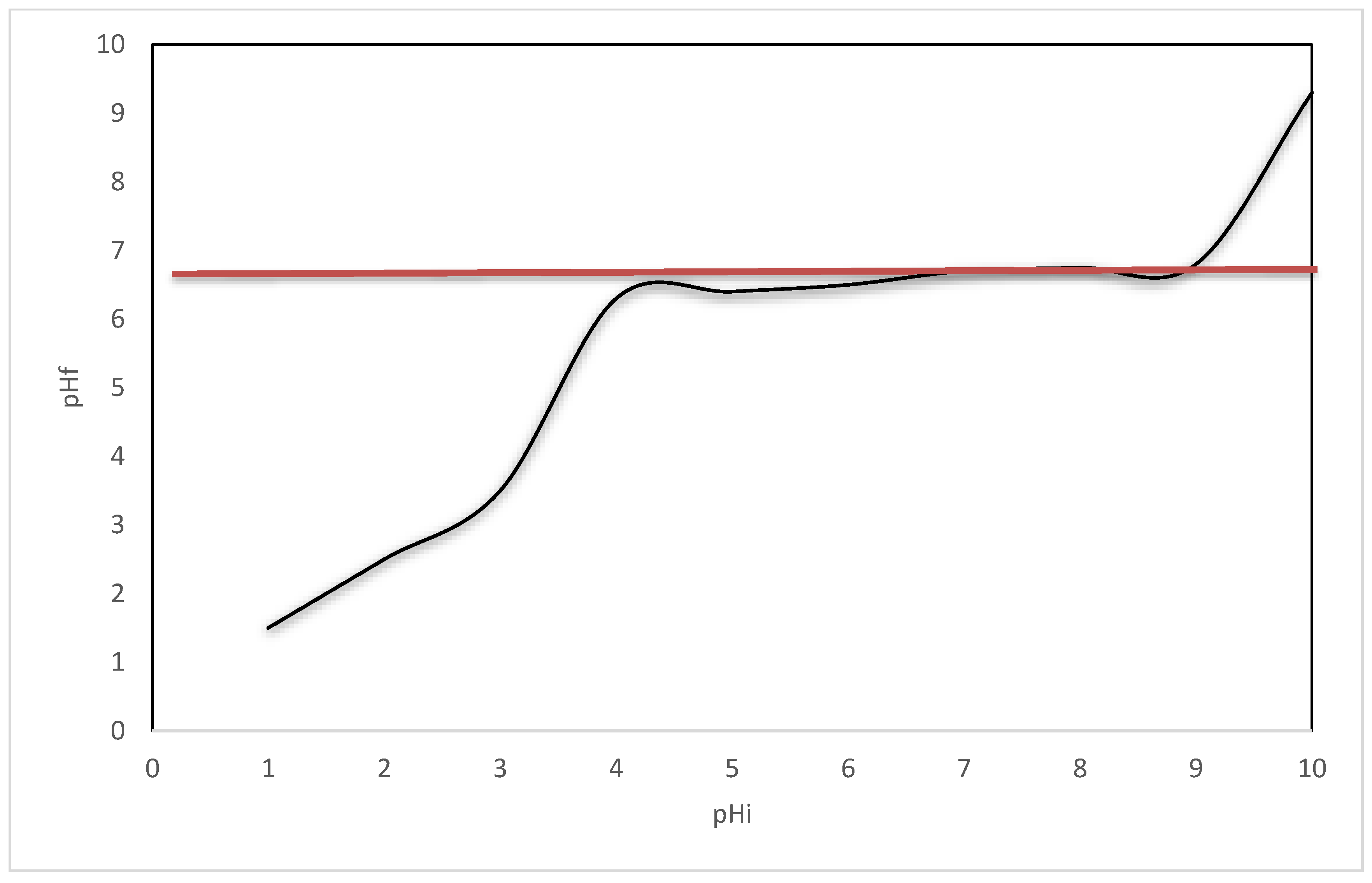

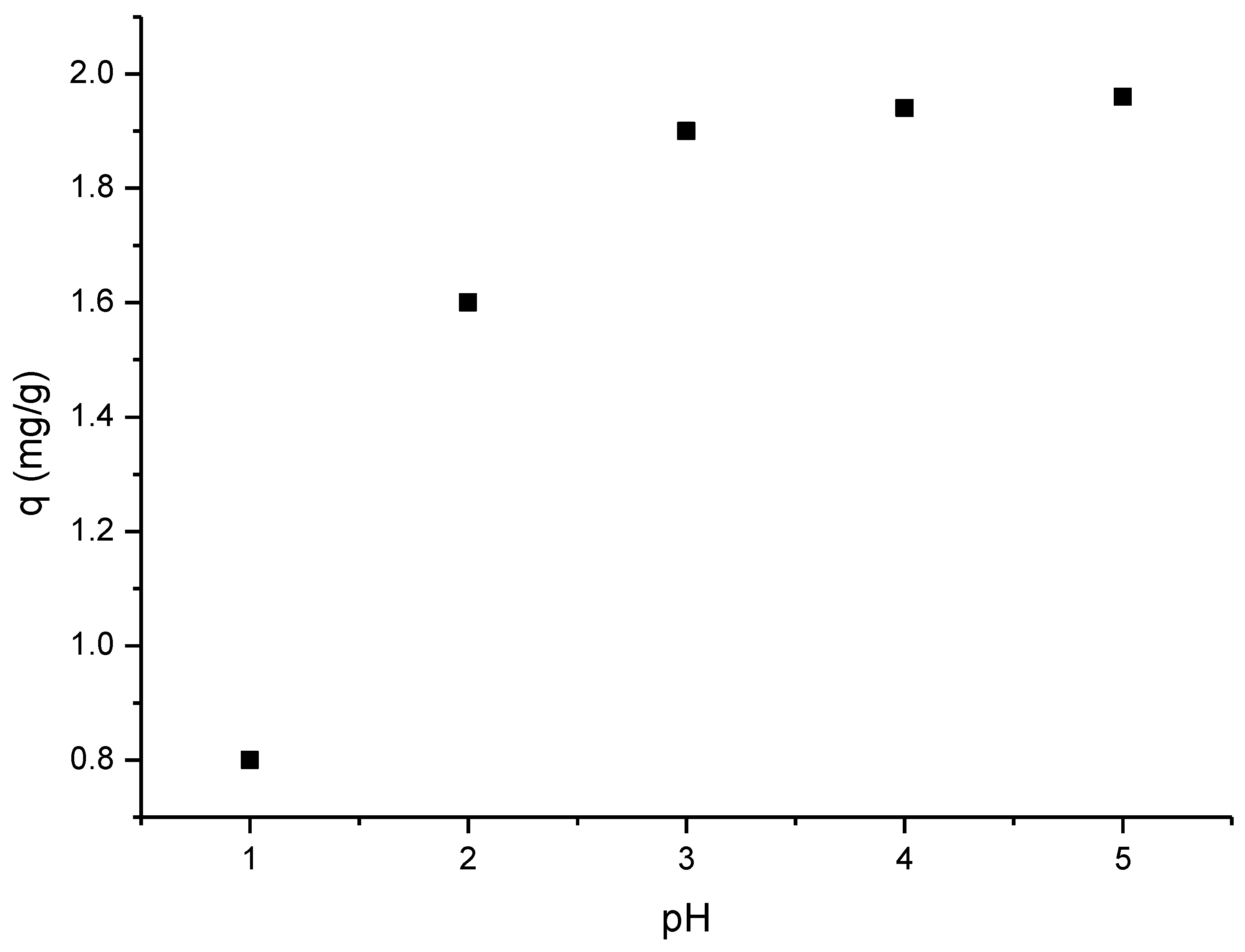
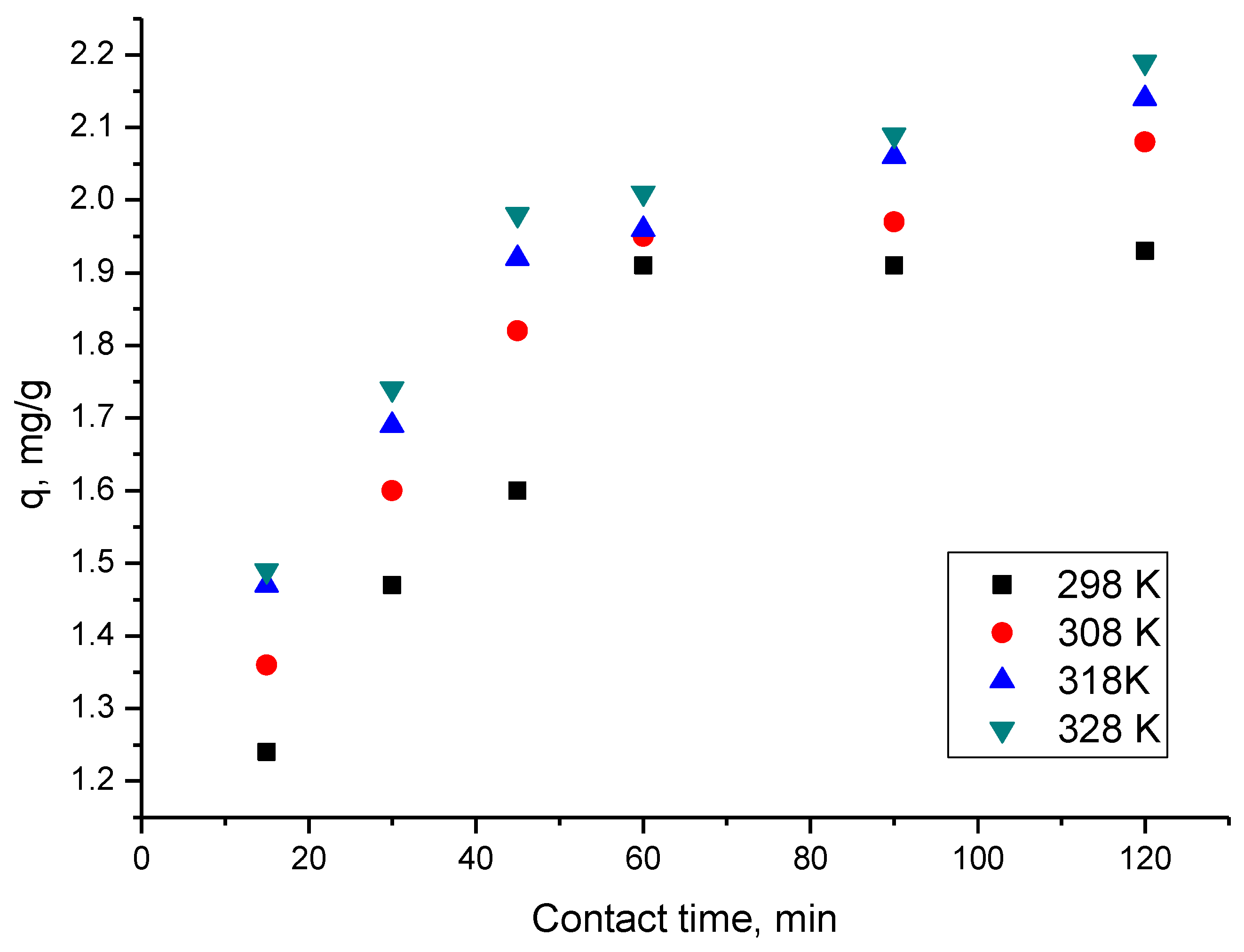
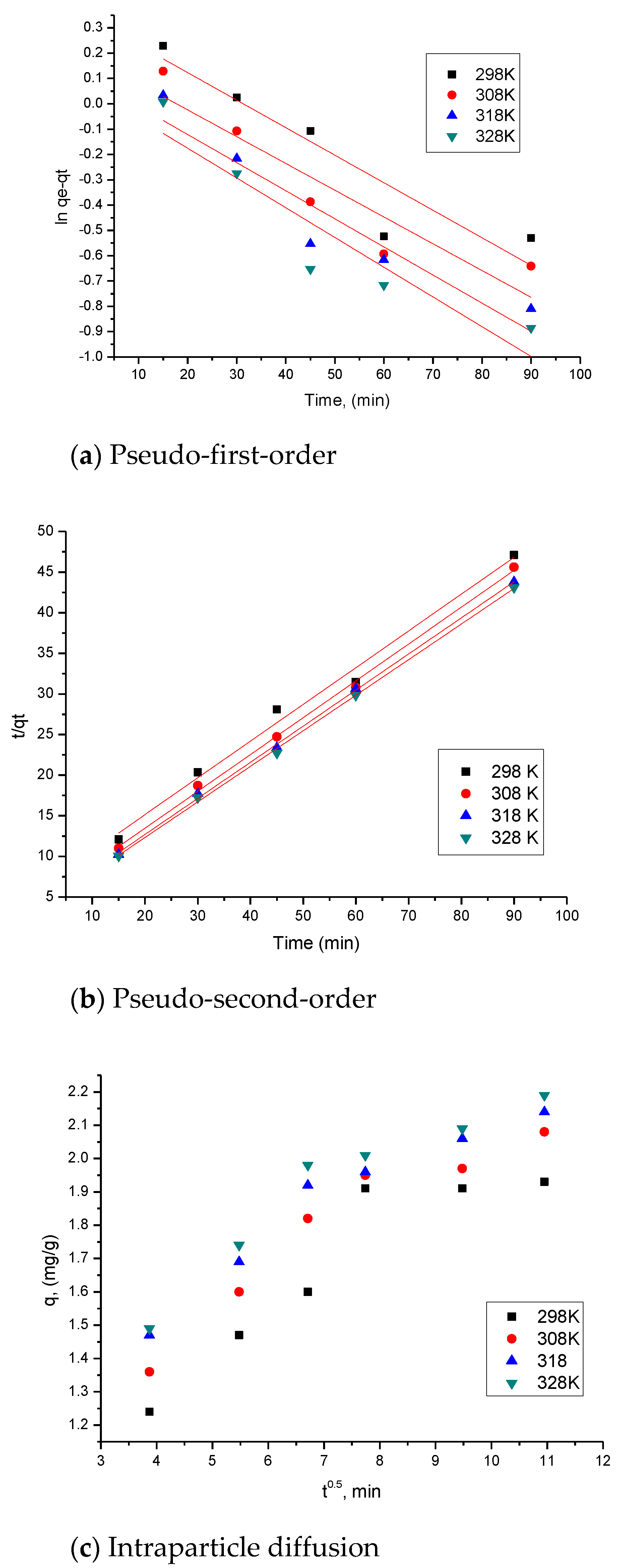
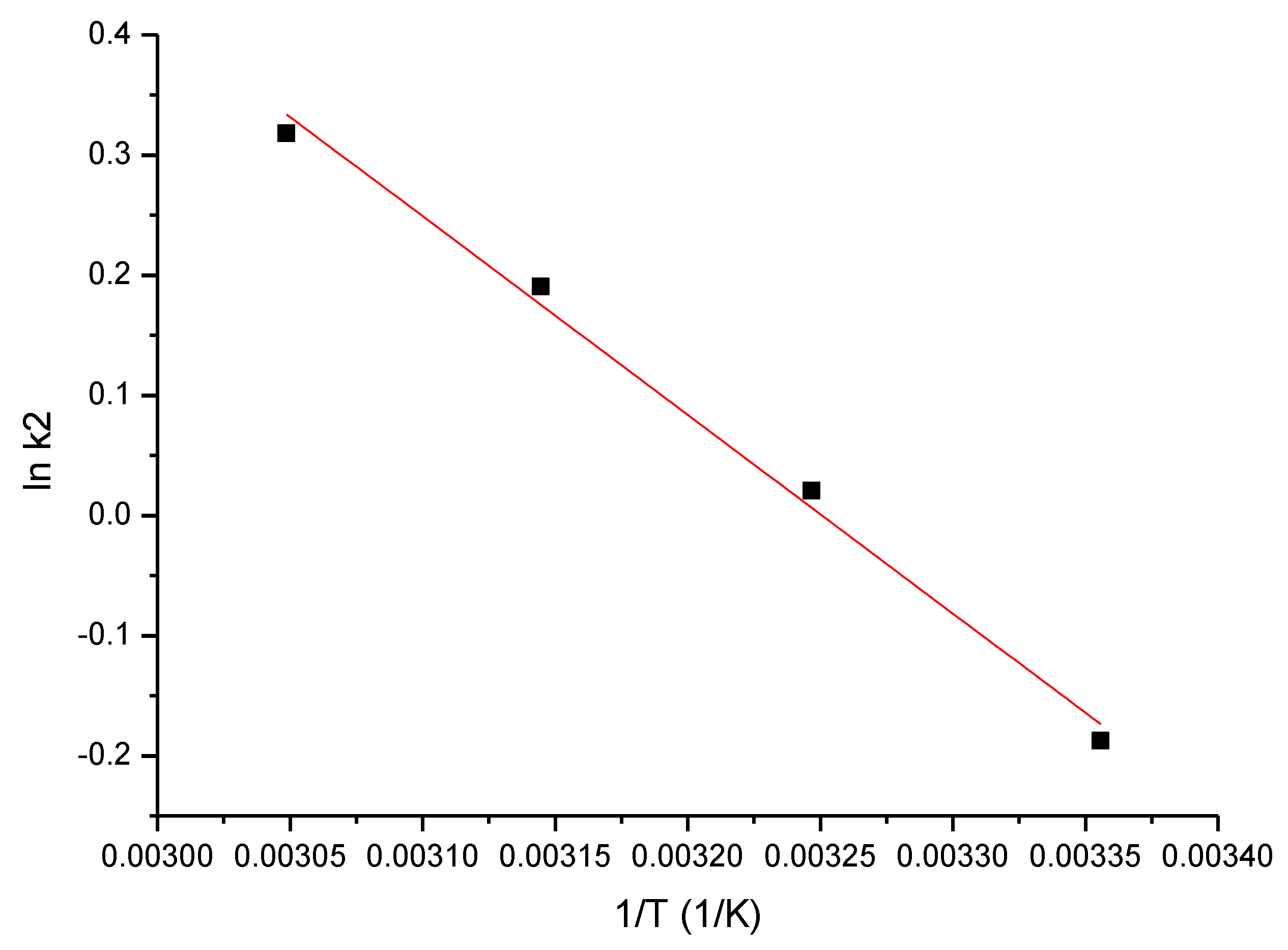
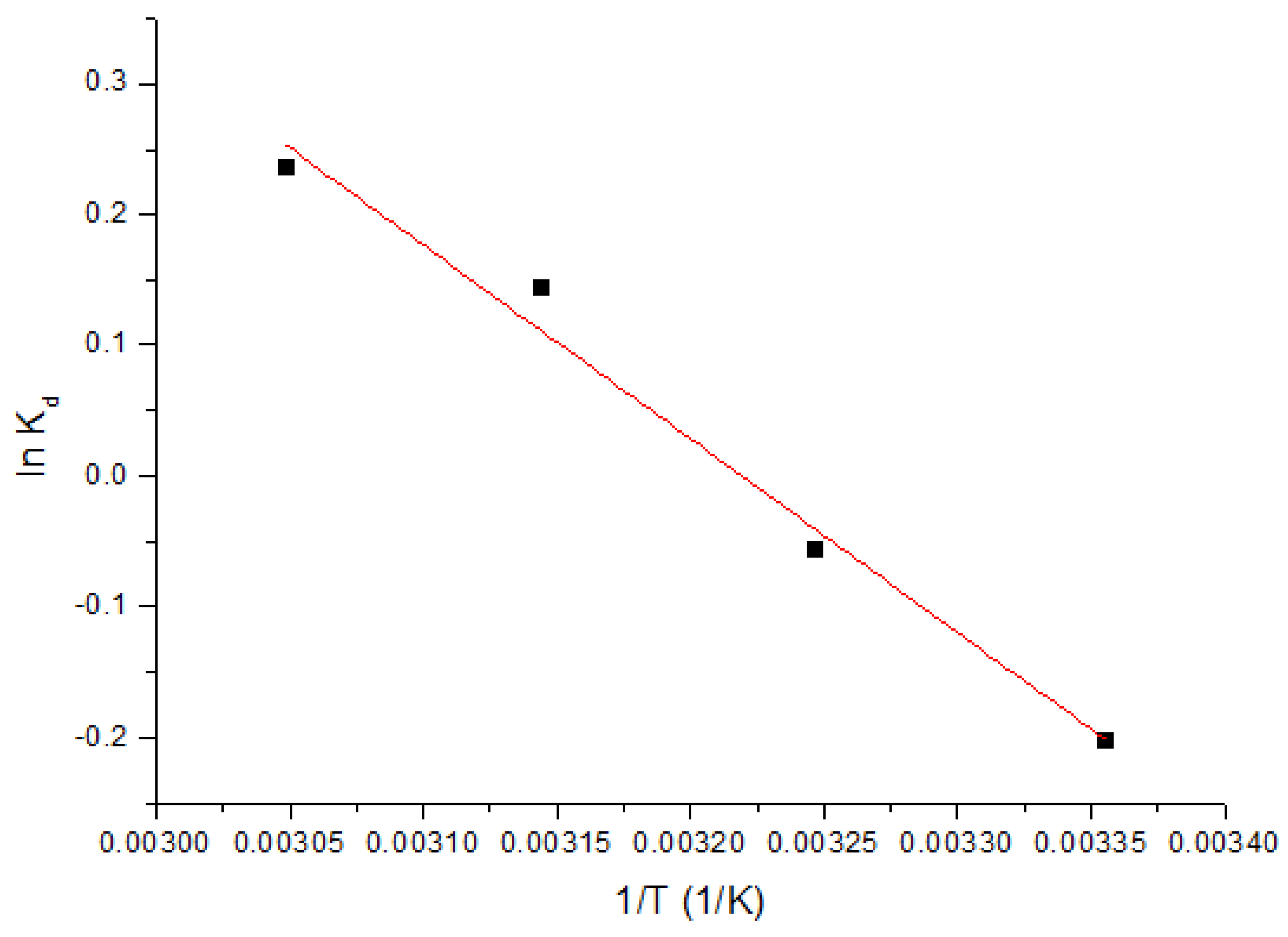
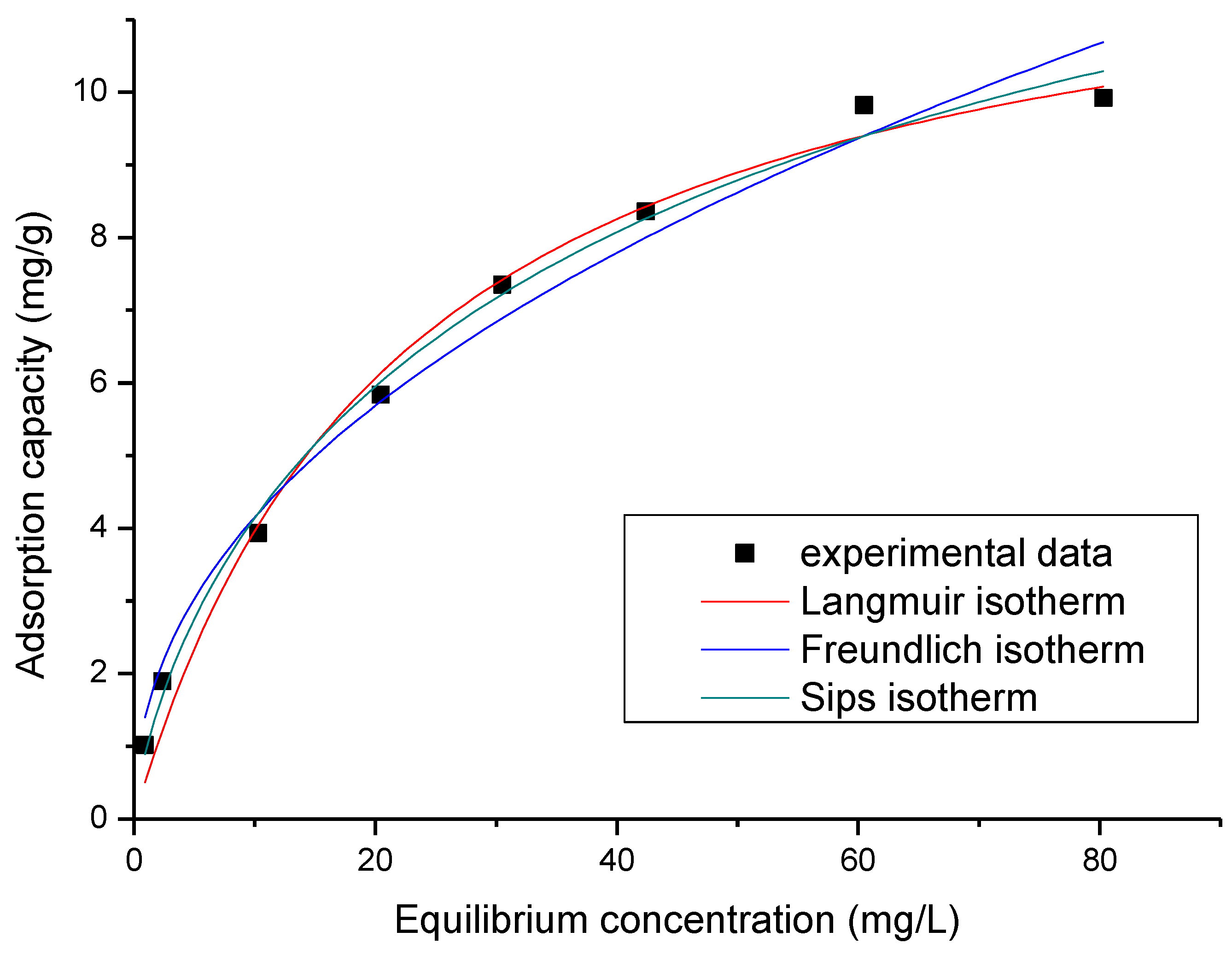
| Samples | BET Specific Area (m2/g) | Langmuir Specific Area (m2/g) | Average Pore Width (nm) |
|---|---|---|---|
| GDAH-01 | 3.5419 | 5.7029 | 4.68861 |
| GDAH-01_260 °C | 2.8412 | 4.2435 | 4.67366 |
| GDAH-01-300 °C | 41.9800 | 61.0822 | 2.70180 |
| GDAH-01-400 °C | 3.1220 | 270.002 | 3.15536 |
| GDAH-02 | 5.9596 | 8.9199 | 10.9876 |
| GDAH-02-260 °C | 10.6208 | 15.5593 | 5.7378 |
| GDAH-02-300 °C | 36.3853 | 52.7869 | 3.7164 |
| GDAH-02-400 °C | 234.4518 | 345.6202 | 3.2249 |
| GDAH-03 | 10.3375 | 16.0231 | 7.1186 |
| GDAH-03_260 °C | 10.3094 | 15.5083 | 5.9023 |
| GDAH-03_300 °C | 65.5179 | 95.2101 | 3.1337 |
| GDAH-03_400 °C | 241.9623 | 356.6276 | 3.3867 |
| GDAH-04 | 9.4725 | 14.0771 | 7.4804 |
| GDAH-04_260 °C | 19.4569 | 28.2606 | 5.4720 |
| GDAH-04_300 °C | 6.9195 | 10.0146 | 3.7566 |
| GDAH-04_400 °C | 238.6443 | 350.5961 | 3.2303 |
| GDAH-05 | 2.2240 | 7.3240 | 4.3304 |
| GDAH-05_260 °C | 2.2964 | 3.7623 | 6.1816 |
| GDAH-05_300 °C | 20.8556 | 30.3694 | 3.8894 |
| GDAH-05_400 °C | 181.5672 | 267.8954 | 3.5443 |
| Mineral Name | Gibbsite (%) | Boehmite (%) | Gamma-Al2O3 (%) | Crystallinity (%) |
|---|---|---|---|---|
| Formula | Al(OH)3 | γ-AlOOH | γ-Al2O3 | |
| GDAH-01 | 41.65 | 0 | 0 | 58.35 |
| GDAH-02 | 62.54 | 0 | 0 | 37.46 |
| GDAH-03 | 61.67 | 0 | 0 | 38.33 |
| GDAH-04 | 62.59 | 0 | 0 | 37.41 |
| GDAH-02 | 90 | 0 | 1.6 | 62.54 |
| GDAH-02-260 | 91.8 | 8 | 0.1 | 50.57 |
| GDAH-02-300 | 78.8 | 13.1 | 1.5 | 41 |
| GDAH-02-400 | 15.7 | 35.7 | 48.3 | 21.4 |
| GDAH-03 | 97.2 | 0 | 0 | 61.67 |
| GDAH-03-260 | 93.2 | 6.2 | 0.5 | 48.21 |
| GDAH-03-300 | 80 | 11 | 1.3 | 43.75 |
| GDAH-03-400 | 0.2 | 26.3 | 57.7 | 18.30 |
| GDAH-04 | 88.9 | 0 | 0.8 | 62.59 |
| GDAH-04-260 | 89.3 | 4.9 | 1.4 | 55.85 |
| GDAH-04-300 | 76.7 | 10.4 | 2.5 | 49.38 |
| GDAH-04-400 | 8.7 | 30.4 | 57.1 | 22.12 |
| GDAH-05 | 99.9 | 0 | 0 | 55.56 |
| GDAH-05-260 | 84.1 | 15.9 | 0 | 51.76 |
| GDAH-05-300 | 73.8 | 26.2 | 0 | 45.75 |
| GDAH-05-400 | 0.2 | 48.8 | 50.9 | 26.68 |
| Pseudo-First-Order | ||||
| Temperature (K) | qe,exp (mg g−1) | k1 (min−1) | qe,calc (mg g−1) | R2 |
| 298 | 1.91 | 0.0077 | 1.00 | 0.7889 |
| 308 | 1.97 | 0.0089 | 1.04 | 0.8941 |
| 318 | 2.06 | 0.0246 | 1.13 | 0.921 |
| 328 | 2.09 | 0.0304 | 1.24 | 0.9127 |
| Pseudo-Second-Order | ||||
| Temperature (K) | qe,exp (mg g−1) | k2 (g mg−1∙min−1) | qe,calc (mg g−1) | R2 |
| 298 | 1.91 | 0.83 | 2.14 | 0.9950 |
| 308 | 1.97 | 1.02 | 2.25 | 0.9988 |
| 318 | 2.06 | 1.21 | 2.29 | 0.9993 |
| 328 | 2.09 | 1.37 | 2.33 | 0.9991 |
| Intraparticle Diffusion Model (IPD) | ||||
| Temperature (K) | Kdiff (mg·g−1 min−1/2) | C | R2 | |
| 298 | 2.51 | 12.52 | 0.8797 | |
| 308 | 3.92 | 12.89 | 0.8860 | |
| 318 | 4.04 | 13.02 | 0.8835 | |
| 328 | 4.36 | 13.56 | 0.7848 | |
| ΔH° (kJ/mol) | ΔS° (J/mol∙K) | ΔG° (kJ/mol) | R2 | |||
|---|---|---|---|---|---|---|
| 12.32 | 39.66 | 298 K | 308 K | 318 K | 328 K | 0.9856 |
| −11.80 | −12.20 | −12.60 | −12.99 | |||
| Langmuir isotherm | |||
| qm,exp (mg/g) | KL (L/mg) | qL (mg/g) | R2 |
| 9.82 | 0.044 | 12.91 | 0.9856 |
| Freundlich isotherm | |||
| KF (mg/g) | 1/nF | R2 | |
| 1.46 | 0.45 | 0.9802 | |
| Sips isotherm | |||
| KS | qS (mg/g) | 1/nS | R2 |
| 0.26 | 10.1 | 0.06 | 0.9915 |
| Sample | GDAH-01 | GDAH-02 | GDAH-03 | GDAH-04 | GDAH-05 |
| Particle size | <45 µm = 5.7% >150 mm 6.4% | <45 µm 98.29% | <20 µm 92.13% | <10 µm 76.28% | <45 µm = 5.0% >150 = 3.42% |
| LOI | 34.62 | 34.62 | 34.61 | 34.62 | 34.58 |
| Moisture | 0.082 | 0158 | 0.134 | 0180 | 0.081 |
| Temperature 1 | GDAH-0 | GDAH-01 | GDAH-01 | GDAH-01 | GDAH-01 |
| Temperature 2 | GDAH-01 260 | GDAH-01 260 | GDAH-01 260 | GDAH-01 260 | GDAH-01 260 |
| Temperature 4 | GDAH-01 300 | GDAH-01 300 | GDAH-01 300 | GDAH-01 300 | GDAH-01 300 |
| Temperature 5 | GDAH-01 400 | GDAH-01 400 | GDAH-01 400 | GDAH-01 400 | GDAH-01 400 |
Publisher’s Note: MDPI stays neutral with regard to jurisdictional claims in published maps and institutional affiliations. |
© 2022 by the authors. Licensee MDPI, Basel, Switzerland. This article is an open access article distributed under the terms and conditions of the Creative Commons Attribution (CC BY) license (https://creativecommons.org/licenses/by/4.0/).
Share and Cite
Daminescu, D.; Duţeanu, N.; Ciopec, M.; Negrea, A.; Negrea, P.; Nemeş, N.S.; Berbecea, A.; Dobra, G.; Iliev, S.; Cotet, L.; et al. Scandium Recovery from Aqueous Solution by Adsorption Processes in Low-Temperature-Activated Alumina Products. Int. J. Mol. Sci. 2022, 23, 10142. https://doi.org/10.3390/ijms231710142
Daminescu D, Duţeanu N, Ciopec M, Negrea A, Negrea P, Nemeş NS, Berbecea A, Dobra G, Iliev S, Cotet L, et al. Scandium Recovery from Aqueous Solution by Adsorption Processes in Low-Temperature-Activated Alumina Products. International Journal of Molecular Sciences. 2022; 23(17):10142. https://doi.org/10.3390/ijms231710142
Chicago/Turabian StyleDaminescu, Diana, Narcis Duţeanu, Mihaela Ciopec, Adina Negrea, Petru Negrea, Nicoleta Sorina Nemeş, Adina Berbecea, Gheorghe Dobra, Sorin Iliev, Lucian Cotet, and et al. 2022. "Scandium Recovery from Aqueous Solution by Adsorption Processes in Low-Temperature-Activated Alumina Products" International Journal of Molecular Sciences 23, no. 17: 10142. https://doi.org/10.3390/ijms231710142
APA StyleDaminescu, D., Duţeanu, N., Ciopec, M., Negrea, A., Negrea, P., Nemeş, N. S., Berbecea, A., Dobra, G., Iliev, S., Cotet, L., Boiangiu, A., & Filipescu, L. (2022). Scandium Recovery from Aqueous Solution by Adsorption Processes in Low-Temperature-Activated Alumina Products. International Journal of Molecular Sciences, 23(17), 10142. https://doi.org/10.3390/ijms231710142








